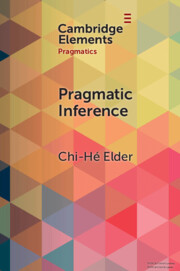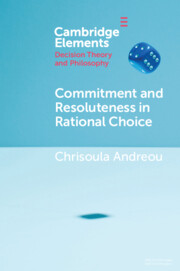73 results
Chapter 3 - The Expert Transition Cycle
- from Part I - Transitions
-
- Book:
- Transition Expertise and Identity
- Published online:
- 30 May 2024
- Print publication:
- 06 June 2024, pp 23-36
-
- Chapter
- Export citation
Chapter 11 - Identity
- from Part IV - The Project of the Self
-
- Book:
- Transition Expertise and Identity
- Published online:
- 30 May 2024
- Print publication:
- 06 June 2024, pp 233-266
-
- Chapter
- Export citation
Chapter 2 - Criteria for a Satisfactory Account of Agnosticism
-
- Book:
- The Attitude of Agnosticism
- Published online:
- 14 March 2024
- Print publication:
- 21 March 2024, pp 6-40
-
- Chapter
- Export citation

Pragmatic Inference
- Misunderstandings, Accountability, Deniability
-
- Published online:
- 19 March 2024
- Print publication:
- 21 March 2024
-
- Element
- Export citation
8 - Exploring Sen on self-interest and commitment
- from Part II - Inclusiveness, Social and Individual Agency
-
-
- Book:
- Social Choice, Agency, Inclusiveness and Capabilities
- Published online:
- 28 March 2024
- Print publication:
- 14 March 2024, pp 170-201
-
- Chapter
- Export citation
6 - Suicide and Civil Commitment
-
- Book:
- Practical Ethics in Suicide
- Published online:
- 15 February 2024
- Print publication:
- 22 February 2024, pp 102-117
-
- Chapter
- Export citation
Chapter 9 - Unpacking Social Articulation of Agency
-
-
- Book:
- Agency and Transformation
- Published online:
- 23 November 2023
- Print publication:
- 30 November 2023, pp 209-229
-
- Chapter
- Export citation
6 - From Fledgling to Established Relationships
- from Part II - Relationship Formation
-
- Book:
- The Science of Romantic Relationships
- Published online:
- 17 August 2023
- Print publication:
- 31 August 2023, pp 197-234
-
- Chapter
- Export citation
Lying with Uninformative Speech Acts
-
- Journal:
- Canadian Journal of Philosophy / Volume 52 / Issue 7 / October 2022
- Published online by Cambridge University Press:
- 08 May 2023, pp. 746-760
-
- Article
-
- You have access
- Open access
- HTML
- Export citation
Stage 8 - Meaning in Service of Its Makers
-
- Book:
- Semantics, Pragmatics, Philosophy
- Published online:
- 22 March 2023
- Print publication:
- 16 March 2023, pp 291-359
-
- Chapter
- Export citation
Malaysian Firms’ Role in Retaining Engineers
-
- Journal:
- The Economic and Labour Relations Review / Volume 23 / Issue 4 / November 2012
- Published online by Cambridge University Press:
- 01 January 2023, pp. 57-77
-
- Article
- Export citation
Implementing the commitment solution via discretionary policy-making
-
- Journal:
- Macroeconomic Dynamics / Volume 27 / Issue 7 / October 2023
- Published online by Cambridge University Press:
- 24 October 2022, pp. 1866-1892
-
- Article
-
- You have access
- Open access
- HTML
- Export citation
19 - Men’s Attachment-Related Needs in the Sexual Arena
- from Part III - Postcopulatory Adaptations
-
-
- Book:
- The Cambridge Handbook of Evolutionary Perspectives on Sexual Psychology
- Published online:
- 30 June 2022
- Print publication:
- 21 July 2022, pp 451-475
-
- Chapter
- Export citation
17 - Emotional Commitment in Men
- from Part III - Postcopulatory Adaptations
-
-
- Book:
- The Cambridge Handbook of Evolutionary Perspectives on Sexual Psychology
- Published online:
- 30 June 2022
- Print publication:
- 21 July 2022, pp 391-425
-
- Chapter
- Export citation
3 - Digital Media and the Dual Aspect of Adolescent Identity Development
- from Part II - Digital Media in the Adolescent Developmental Context
-
-
- Book:
- Handbook of Adolescent Digital Media Use and Mental Health
- Published online:
- 30 June 2022
- Print publication:
- 14 July 2022, pp 63-84
-
- Chapter
-
- You have access
- Open access
- HTML
- Export citation
The “Glorious” Revolution’s Inglorious Religious Commitment: Why Parliamentary Rule Failed to Secure Religious Liberty
-
- Journal:
- Social Science History / Volume 46 / Issue 4 / Winter 2022
- Published online by Cambridge University Press:
- 04 July 2022, pp. 693-718
- Print publication:
- Winter 2022
-
- Article
- Export citation
4 - The Distant Command of the Greeks
-
- Book:
- Tyranny and Revolution
- Published online:
- 28 May 2022
- Print publication:
- 19 May 2022, pp 187-262
-
- Chapter
- Export citation
Do smallholder farmers prefer commitment or flexibility in pension savings accounts? A randomised experiment of cocoa farmers in Ghana
-
- Journal:
- Journal of Pension Economics & Finance / Volume 22 / Issue 1 / January 2023
- Published online by Cambridge University Press:
- 29 April 2022, pp. 23-37
-
- Article
-
- You have access
- Open access
- HTML
- Export citation
Conclusion
-
- Book:
- Understanding the Private–Public Divide
- Published online:
- 14 April 2022
- Print publication:
- 07 April 2022, pp 171-176
-
- Chapter
- Export citation

Commitment and Resoluteness in Rational Choice
-
- Published online:
- 03 February 2022
- Print publication:
- 03 March 2022
-
- Element
- Export citation



